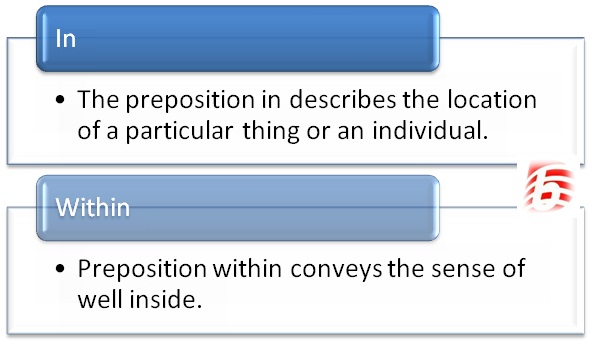In vs Within in English Grammar
Although the words “in” and “within” may sound similar, they have different meanings and uses in English grammar. Both words are primarily used as prepositions, but they also have other functions: “in” can also be used as an adjective and an adverb, while “within” can also be used as an adverb. The preposition “in” is employed to describe the noun in the locative case, while “within” gives the sense of being well inside something.
What does In mean?
According to the Oxford English dictionary, “in” refers to “Expressing the situation of something that is or appears to be enclosed or surrounded by something else.” Essentially, “in” describes the location of a particular object or person. For example, in the sentence “He lives in New York City,” the preposition “in” describes the person’s location.
What does Within mean?
The Oxford English dictionary defines “within” as meaning “inside (something).” For example, in the sentence “He works well within himself,” the word “within” conveys the sense of being well inside and implies that the person works well inside their own self. Here, the word “within” adds the extra meaning of good.
What is the difference between In and Within in English Grammar?
As previously mentioned, the preposition “in” describes the location of a particular thing or individual, while the preposition “within” conveys the sense of being well inside. Additionally, the words “in” and “within” have different meanings when used with other words in various expressions, such as “in time” and “within the given time.” For instance, in the sentences “He came in time” and “He came within two hours,” the words “in” and “within” are used in different senses.
In the first sentence, the preposition “in” implies the sense of advance and suggests that the person arrived early. In the second sentence, the word “within” conveys the sense of under, meaning the person arrived in under two hours. Thus, “within” is used to mean “under,” while “in” is used to mean “advance.” Another example is the phrase “He came in two hours,” in which the preposition “in” is used to mean “at the completion” or “at the stroke of,” indicating that the person arrived at the completion of two hours. Both “in” and “within” are frequently used in combination with several verbs.
Key Takeaways
- The preposition “in” describes the location of a particular thing or individual.
- The preposition “within” conveys the sense of being well inside something.
- “In” and “within” have different meanings when used with other words in various expressions, such as “in time” and “within the given time.”
